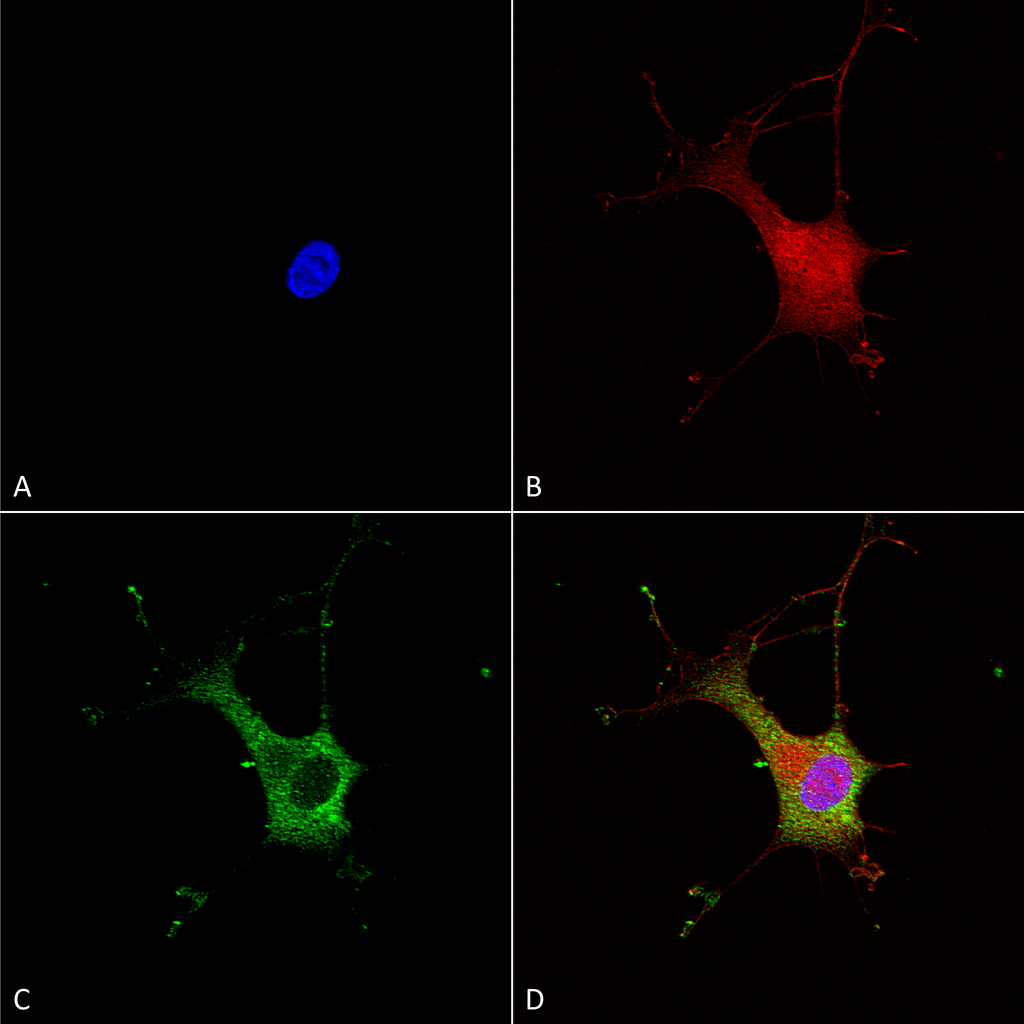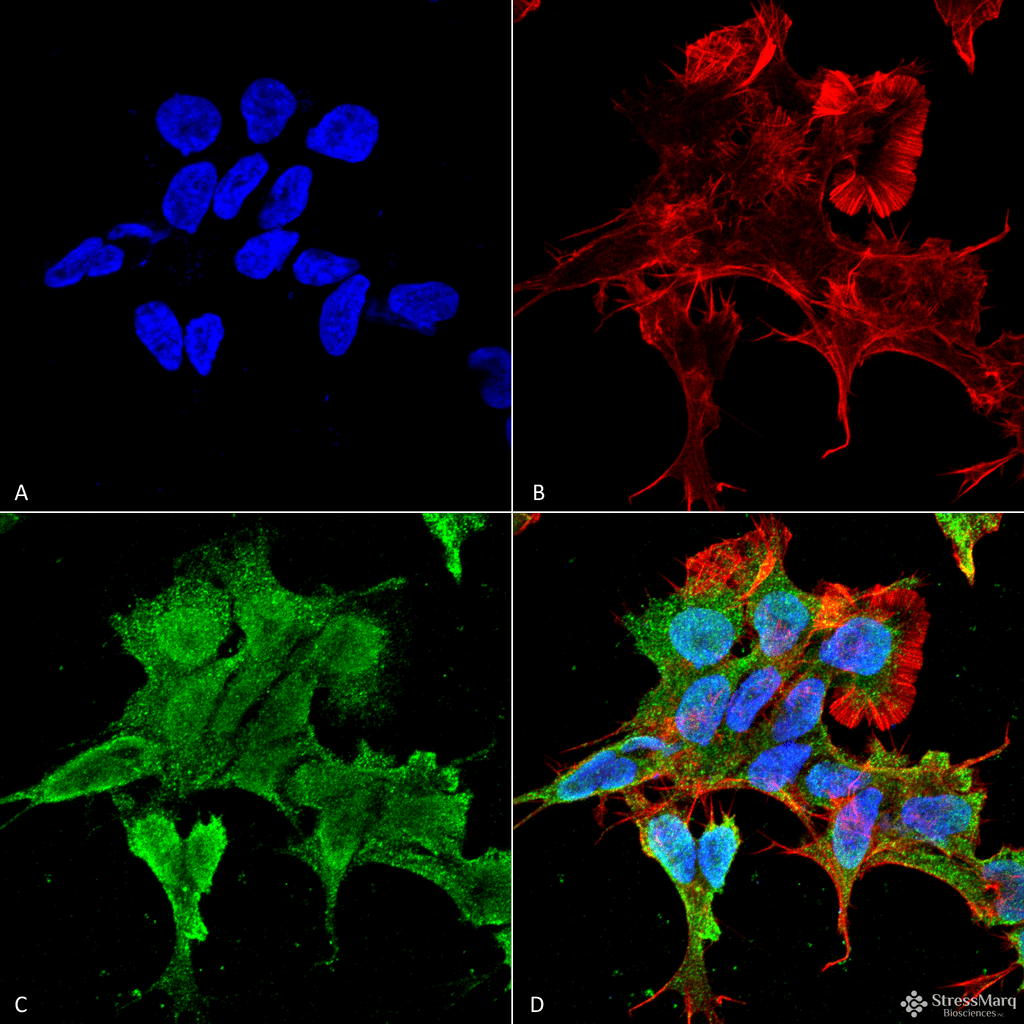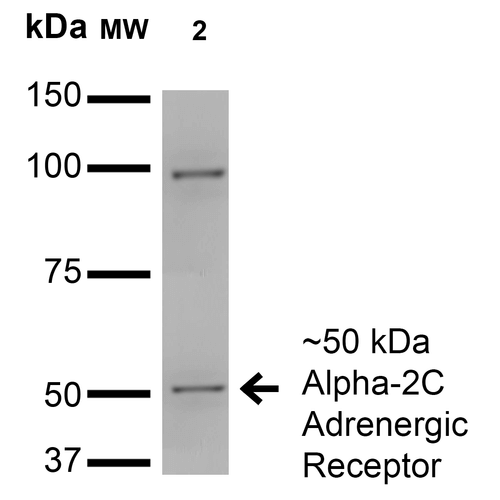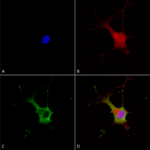Properties
| Storage Buffer | PBS pH7.4, 50% glycerol, 0.09% sodium azide *Storage buffer may change when conjugated |
| Storage Temperature | -20ºC, Conjugated antibodies should be stored according to the product label |
| Shipping Temperature | Blue Ice or 4ºC |
| Purification | Protein G Purified |
| Clonality | Monoclonal |
| Clone Number | N330A/80 (Formerly sold as S330A-80) |
| Isotype | IgG1 |
| Specificity | Detects 50kDa or larger (possibly due to dimerization). Does not cross-react with other adrenergic receptors. |
| Cite This Product | StressMarq Biosciences Cat# SMC-435, RRID: AB_2701577 |
| Certificate of Analysis | 1 µg/ml of SMC-435 was sufficient for detection of Alpha2C Adrenergic Receptor in 20 µg of COS cells transiently transfected with HA-tagged Alpha- lysate and assayed by colorimetric immunoblot analysis using goat anti-mouse IgG:HRP as the secondary antibody. |
Biological Description
| Alternative Names | Adra 2c Antibody, Alpha-2CAR Antibody, ADRA2C Antibody, ADRA2L2 Antibody, ADRARL2 Antibody, Alpha 2CAR Antibody, alpha2 AR C4 Antibody, alpha2 C4 Antibody, alpha2C Antibody, ALPHA2CAR Antibody, Alpha-2 adrenergic receptor subtype C4 Antibody, Alpha-2C adrenoreceptor Antibody, Adrenergic alpha 2C receptor Antibody, Alpha 2C adrenergic receptor Antibody, Alpha 2C adrenergic receptor subtype C4 Antibody, Alpha 2C adrenoceptor Antibody, Alpha 2C adrenoreceptor Antibody, Alpha-2-adrenergic receptor Antibody, renal type Antibody, alpha2cii-adrenergic receptor Antibody, Subtype alpha2 C4 Antibody |
| Research Areas | Alpha-2 Adrenergic Receptors, Cell Signaling, Neuroscience, Neurotransmitter Receptors |
| Cellular Localization | Cell membrane |
| Accession Number | NP_000674.2 |
| Gene ID | 152 |
| Swiss Prot | P18825 |
| Scientific Background | The alpha 2C Adrenergic Receptor controls the release of neurotransmitter from central adrenergic neurons and from sympathetic nerves in the heart. This receptor also plays a role in cognitive and behavioral function. Two variants are produced by alternative splicing. Alpha 2C Adrenergic Receptor has been reported extensively in the brain. Blood, corpus cavermosum, kidney, and heart tissues have also been reported to express the protein. |
| References |
1. Filipeanu C.M., et al. (2011) Biochim Biophys Acta. 1813: 346-357. 2. Powe D.G., et al. (2011) Breast Cancer Res Treat. 130: 457-463. |
Product Images

Immunocytochemistry/Immunofluorescence analysis using Mouse Anti-Alpha-2C Adrenergic Receptor Monoclonal Antibody, Clone N330A/80 (SMC-435). Tissue: Neuroblastoma cells (SH-SY5Y). Species: Human. Fixation: 4% PFA for 15 min. Primary Antibody: Mouse Anti-Alpha-2C Adrenergic Receptor Monoclonal Antibody (SMC-435) at 1:100 for overnight at 4°C with slow rocking. Secondary Antibody: AlexaFluor 488 at 1:1000 for 1 hour at RT. Counterstain: Phalloidin-iFluor 647 (red) F-Actin stain; Hoechst (blue) nuclear stain at 1:800, 1.6mM for 20 min at RT. (A) Hoechst (blue) nuclear stain. (B) Phalloidin-iFluor 647 (red) F-Actin stain. (C) Alpha-2C Adrenergic Receptor Antibody (D) Composite.

Immunocytochemistry/Immunofluorescence analysis using Mouse Anti-Alpha-2C Adrenergic Receptor Monoclonal Antibody, Clone N330A/80 (SMC-435). Tissue: Neuroblastoma cell line (SK-N-BE). Species: Human. Fixation: 4% Formaldehyde for 15 min at RT. Primary Antibody: Mouse Anti-Alpha-2C Adrenergic Receptor Monoclonal Antibody (SMC-435) at 1:100 for 60 min at RT. Secondary Antibody: Goat Anti-Mouse ATTO 488 at 1:100 for 60 min at RT. Counterstain: Phalloidin Texas Red F-Actin stain; DAPI (blue) nuclear stain at 1:1000, 1:5000 for 60min RT, 5min RT. Localization: Cell Membrane, Nucleus. Magnification: 60X. (A) DAPI (blue) nuclear stain. (B) Phalloidin Texas Red F-Actin stain. (C) Alpha-2C Adrenergic Receptor Antibody. (D) Composite.

Western Blot analysis of Monkey COS cells transfected with HA-tagged Alpha-2C showing detection of ~50 kDa Alpha-2C Adrenergic Receptor protein using Mouse Anti-Alpha-2C Adrenergic Receptor Monoclonal Antibody, Clone N330A/80 (SMC-435). Lane 1: Molecular Weight Ladder. Lane 2: Monkey COS cells transfected with HA-tagged Alpha-2C. Load: 15 µg. Block: 2% BSA and 2% Skim Milk in 1X TBST. Primary Antibody: Mouse Anti-Alpha-2C Adrenergic Receptor Monoclonal Antibody (SMC-435) at 1:200 for 16 hours at 4°C. Secondary Antibody: Goat Anti-Mouse IgG: HRP at 1:1000 for 1 hour RT. Color Development: ECL solution for 6 min in RT. Predicted/Observed Size: ~50 kDa.






















Reviews
There are no reviews yet.